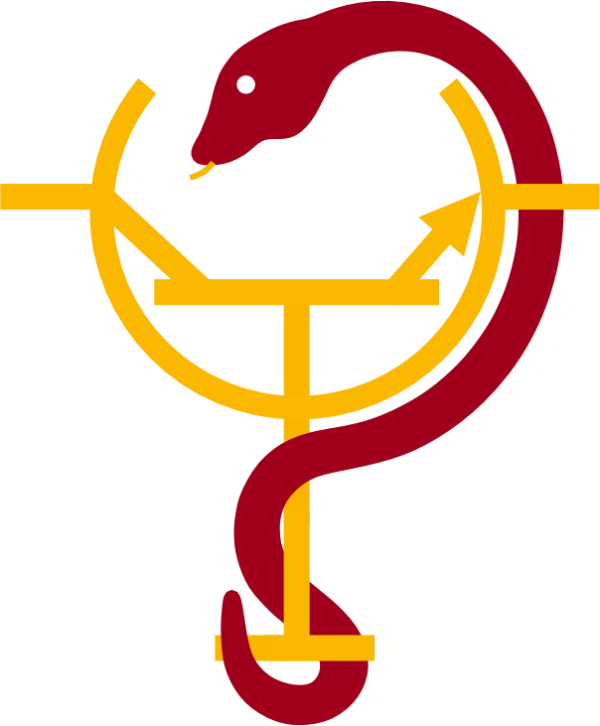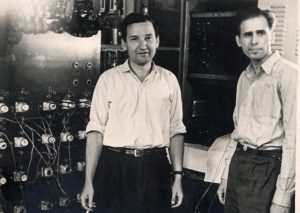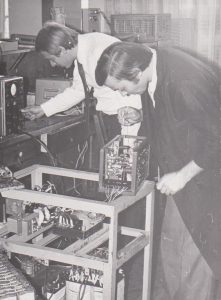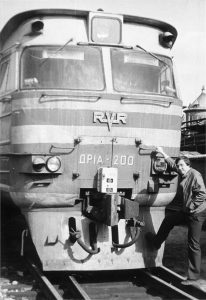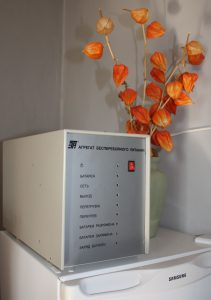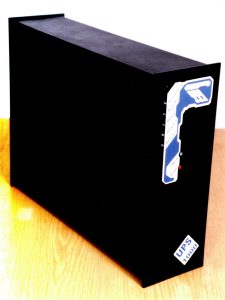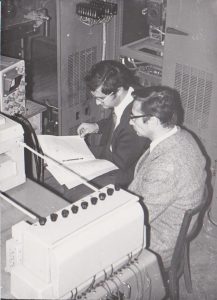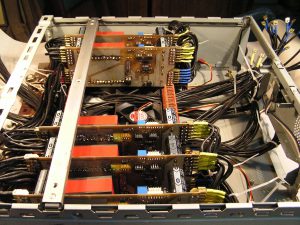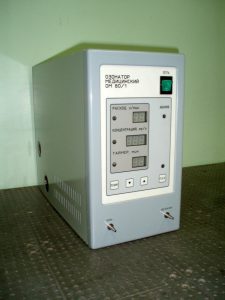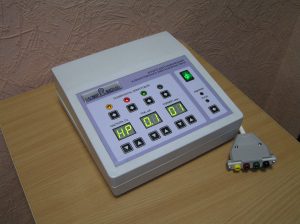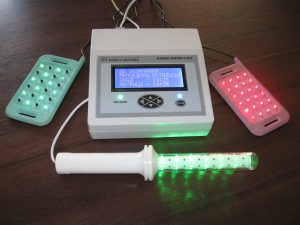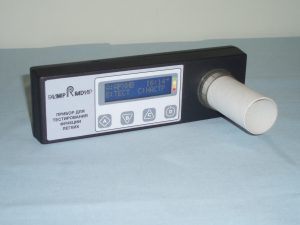The scientific school “Transformative Technique” originated within the department of “Industrial Electronics” at the Kharkiv Polytechnic Institute. This work was led by a talented teacher and researcher, O.O. Maievskyi. In 1963, the department of electrification of industrial enterprises at KPI was divided into two departments: “Electrification of Industrial Enterprises” and “Industrial Electronics.”
The newly established “Industrial Electronics” department included Associate Professors O.O. Maievskyi and V.T. Dolbnya, Senior Lecturers Yu.O. Rozanov, I.P. Arkhierieiev, Ye.A. Fesenko, Assistants V.V. Hubernatorova, V.D. Zemliakov, Ye.V. Lynnyk, Senior Laboratory Technician O.I. Kondratieva, Mechanic V.M. Gozhenko, and Laboratory Assistants V.P. Dziuba and N.A. Kozlitin. Associate Professor V.T. Dolbnya was appointed to serve as the acting head of the department.
The staff of the “Industrial Electronics” department prepared lecture courses and laboratory workshops for all the specialized disciplines in the curriculum of the new specialty. In 1964, after returning from creative leave, Associate Professor O.O. Maievskyi took over as the head of the department. In 1967, he defended his doctoral dissertation on “Integral Methods for Studying Ways to Improve the Energy Performance of Deeply Regulated Valve Converters.”
Yu.P. Honcharov and V.T. Dolbnya engaged in discussing scientific issues.
The topic of scientific works carried out by the department during the 1960s-1970s was related to transformative techniques. This direction was reflected in the book Energy Indicators of Valve Converters. Research on the energy indicators of valve converters was conducted by V.T. Dolbnya, V.P. Bondarenko, Yu.O. Rozanov, Ye.O. Fesenko, and O.M. Semko. Electromagnetic processes in autonomous inverters were studied by Yu.P. Honcharov and V.B. Klepikov, while research on valve multipliers was undertaken by I.P. Arkhierieiev. Charging rectifiers were investigated by O.I. Danylevych. Additionally, O.P. Kotlyarov, O.I. Buileyko, and O.I. Kirichek worked on the development of measuring instruments for studying valve converters.
I.P. Arkhierieiev and Yu.O. Rozanov near the transformative installation.
V.T. Dolbnya simultaneously conducted research on the application of topological methods for analyzing electromagnetic processes in electronic circuits. In 1971, Associate Professor V.T. Dolbnya was elected as the head of the department.
From the early 1970s, the department began research on the dynamics of closed-loop systems under the leadership of Professor V.P. Shipillo. Starting in 1979, a new direction emerged focused on developing microprocessor-based control systems for energy converters, led by Associate Professor Ye.I. Sokol.
In 1991, a new research area called “Biomedical Electronics” was introduced. By 1998, a specialized laboratory, which focused on the research and development of medical devices, became part of the research and medical-diagnostic complex jointly created by NTU “KhPI” and the Research Institute of Radiotechnical Measurements.
In 1967, at the Electromechanical Faculty of KhPI, a Scientific Council was established for defending Ph.D. theses across several specialties in electrical and radio engineering profiles, including transformative techniques. Associate Professor V.T. Dolbnya was appointed as the Chairman of the Council.
Next, the department was headed by Associate Professor Ye.I. Sokol, who, after defending his doctoral dissertation in 1994, became a professor.
The first dissertations defended under this council were by graduate students of Professor O.O. Maievskyi:
- In 1968:
- Yu.P. Honcharov: Methods for Analyzing Processes in Autonomous Inverters under Asymmetrical Loads.
- Yu.O. Rozanov: Development and Study of Asymmetrically Controlled Converters for Valve Electric Drives.
- In 1970:
- O.I. Danylevych: Research and Development of Charging Rectifiers with Inductive Current Limiter for Magnetic Pulse Devices.
- O.P. Kotlyarov: Measurement Methods and Devices in Transformative Techniques.
- In 1972:
- V.B. Klepikov (supervised by Associate Professor S.M. Bazhenov).
- O.M. Semko (supervised by Associate Professor V.T. Dolbnya).
- I.P. Arkhierieiev: Research on Steady-State Operating Modes of Valve Frequency Multipliers with Direct Coupling (supervised by Associate Professor Yu.P. Honcharov).
- In 1973:
- Sunanto (supervised by Associate Professor Yu.O. Rozanov).
-
In 1974:
- Ye.O. Fesenko (supervised by Professor V.P. Shipillo).
The main part of scientific research at the department of “Industrial and Biomedical Electronics” revolves around a common theme: “Optimization of energy and dynamic indicators of valve converters and systems based on them.” Three relevant directions can be distinguished here:
Research conducted within the direction “Development and study of autonomous converters” was led by Professor Yu.P. Honcharov.
Since 1973, more than 15 contract-based projects have been completed in this direction. These included the development of converters used as uninterrupted power supply units in the chemical industry (Dniprodzerzhynsk and Rivne enterprises “Azot”), in energy production (Nebitdag State Regional Electric Power Station), in the gas industry (pipeline “Central Asia – Center”), in automation (Special Design Bureau “Automatic Control Systems”), pulse-width modulation converters commissioned by the USSR Ministry of Defense, and photovoltaic energy converters for agriculture (All-Union Institute of Electrification of Agriculture), among others
The topics of scientific research are divided into the following sections:
Uninterrupted power supply units and special-purpose power sources with high energy and dynamic performance.
These scientific and practical developments were carried out according to the plans of the USSR State Committee for Science and Technology (GKNT) and the objectives of the interuniversity targeted program “Optimum.” Since 1992, they have been based on principles of creative collaboration with Ukrainian enterprises in the electrical engineering field.
The work was carried out by department employees S.Yu. Kryvosheiev, V.V. Zamaruiev, V.V. Ivakhno, and O.V. Yeresko at enterprises such as Dniprodzerzhynsk “Azot”; the “Central Asia–Center” pipeline; energy enterprises in Donbas; converters in solar energy systems (Turkmenistan); and converters for particle accelerators in Lubny, among others.
M.H. Greul and S.Yu. Kryvosheiev worked on setting up the control system for DRZh-3.
The production of converters developed by KhPI researchers was organized at the Kharkiv plant “Electromashyna,” the Tallinn Electrotechnical Plant, the experimental plant of NTU “KhPI,” and others.
The results of scientific research were defended in Ph.D. dissertations by:
- M.O. Tymchenko: Switching Nodes with Saturated Current-Limiting Reactors for Low-Voltage Converters (1981).
- V.V. Ivakhno: Control System for Two-Link Converters Based on a Series Resonant Inverter (1992).
- V.V. Zamaruev: Converters Based on Resonant Inverters for Supplying Pulse Loads (1995).
- S.Yu. Kryvosheiev: Development of a Method for Analyzing and Structuring Semiconductor Converters with High-Speed Frequency Regulators (1999).
- O.V. Yeresko: Means for Improving the Characteristics of Converters with Sinusoidal PWM (2001).
Semiconductor converters for energy-efficient power supply systems of railways and metro networks.
In 1982, Senior Researcher S.M. Nikulochkin, together with V.V. Zamaruiev and V.V. Ivakhno, initially on their own initiative and later at the Special Design Bureau of the “Electromashyna” plant (Kharkiv), conducted work on the creation of a transistor converter for regulating the excitation of the starter-generator of a diesel locomotive. This converter was put into production in 1985. Scientific research in this direction was also conducted by Associate Professor M.H. Greul, Senior Researcher S.M. Ivanov, and Senior Researcher V.I. Kryvosheia.
S.M. Nikulochkin with a PPS-20-110 type converter near a diesel locomotive at the depot in Riga.
In collaboration with specialists from the State Research and Scientific Center of Ukrzaliznytsia, since 2006 the department has been developing structures with longitudinal power transmission lines at an increased voltage of 6–10 kV. These lines are connected to the main 3 kV contact network through transformerless direct current converters. This ensures constant voltage in the contact network, thereby increasing the efficiency and capacity of the power supply system.
Currently, such developments are being carried out for sections of the Southern and Prydniprovska Railways: Kharkiv-Lyubotyn and Lozova-Simferopol. For operating direct current traction substations, the department is developing semiconductor voltage-boost converters commissioned by Ukrzaliznytsia.
Flexible power transmission systems (FACTS) with voltage waveform, phase number, and frequency conversion.
Global energy systems have begun to advance significantly in recent years, driven by new achievements in the electronics industry—specifically, the development and implementation of high-power, high-speed semiconductor devices such as IGBTs and GTOs.
The new concept seeks to preserve Dolivo-Dobrovolsky’s idea of efficiently transmitting energy using high-voltage alternating current while eliminating the “losses” associated with the limitations of the past component base: the sine wave as the fundamental signal of FACTS, three phases, and the low frequency (50 Hz).
The development of high-voltage transformative technology and its application in transportation posed the challenge of simultaneously controlling thyristors located at considerable distances from each other. To address this issue, a control pulse generator scheme was developed, recognized as an invention, and mass-produced by the Tallinn Electrotechnical Plant named after Kalinin. For this development, in 1988, V.I. Kryvosheia and S.M. Nikulochkin were awarded the title “Inventor of the USSR.”
O.V. Yeresko working on setting up a converter in the Karakum Desert.
The department staff, including Associate Professor E.I. Zaika, Yu.D. Sakara, M.H. Greul, S.Yu. Kryvosheiev, and O.V. Yeresko, developed and researched power supplies based on autonomous inverters as well as controllers for managing high-power transistors.
Based on the research, the following Ph.D. dissertations were successfully defended:
- E.I. Zaika: Operation of Inverters on Branched Loads (1973).
- L.M. Tjomkina: Nodes of Parallel Capacitive Switching (1975).
- M.V. Panasenko (1976).
- Yu.D. Sakara: Research on Transient Processes in Autonomous Inverters with Output Filters (1978).
In 1980, by order of the “Electrosila” Research and Production Association (Leningrad), V.V. Zamaruiev, V.V. Ivakhno, and S.M. Nikulochkin, under the scientific supervision of Yu.P. Honcharov, began work on the creation of a thyristor converter for controlling ship propulsion electric motors (responsible executor: V.A. Sheienko). A prototype of the converter was developed, successfully tested at the P.S. Nakhimov Sevastopol Higher Naval School, and handed over to the customer.
In the 1980s–1990s, under the guidance of Yu.P. Honcharov, V.V. Zamaruiev and V.V. Ivakhno developed a series of converters commissioned by the Special Design Bureau “Soyuzmorinzheologiya” (Riga). These converters were designed to operate with electromagnetic, electro-spark, and piezoelectric emitters as part of marine geological exploration complexes (with V.V. Zamaruiev as the responsible executor).
The converters, built to world-class standards, were housed in mobile units located up to 1200 meters from the vessel, generating voltage pulses of predetermined shapes. The uniqueness of the development is confirmed by five invention certificates
Backup power source for household consumers.
The theory of resonant converters was further developed during work on the power supply for an alphanumeric printing device commissioned by the “ShchetMash” plant in Lubny. The use of transistors in the resonant inverter circuit allowed for an increase in the power supply’s capacity while maintaining its dimensions and reducing electromagnetic interference. The implementation of the developed power supply enabled an increase in the printing speed of the alphanumeric printing device ACPU-6362 by 20-50%, from 80 to 120 lines per minute.
Throughout the 1990s, the department’s researchers focused on the development of household devices, including an electronic transformer for halogen lamps, an asynchronous generator for small-scale energy systems, and a backup power source for household consumers during rolling blackouts. The backup power source was mass-produced by one of KhPI’s divisions.
In the early 2000s, scientific developments were applied to a backup power supply for telecommunications equipment, created upon the request of the State Enterprise “Kharkiv Instrument-Building Plant named after T.G. Shevchenko.” Together with V.V. Zamaruiev and V.V. Ivakhno, a young researcher, V.O. Makarov, contributed to this development. This work led to research forming the basis of his defended Ph.D. dissertation: Backup AC Source for Critical Consumers (2009).
The development was recognized with a diploma at the 5th specialized exhibition “Electronics. Informatics. Communication” in 2005.
Backup power supply for telecommunications equipment.
In recent years, alongside advancements in circuit solutions and academic work in the field of conversion technology theory, department scientists have also focused significantly on applied aspects of designing electrical energy converters. This was particularly evident in 2001 during the development, manufacturing, and research of a matrix converter, which was carried out under a U.S. commission by the Institute of Electrodynamics of the National Academy of Sciences of Ukraine (E.M. Chekhet, Ye.I. Sokol, I.F. Domnin, V.V. Zamaruiev).
Work conducted under the direction of Professor Ye.I. Sokol focused on the “Development and Research of Microprocessor Control Systems for Semiconductor Converters.”
Since the early 1980s, under the scientific guidance of Associate Professor (later Professor) Ye.I. Sokol, research on microprocessor control systems began. Scientists such as I.F. Domnin, Yu.S. Zinin, M.A. Shyshkin, V.V. Yerysova, N.D. Levytska, and L.V. Fetyukhina worked on power systems for the accelerator-storage complex.
Microprocessor-based control systems for thyristor electric drives used in casting production facilities were developed by A.V. Kypenskyi, L.V. Fetyukhina, Yu.I. Kolesnik, and V.I. Riabenkyi. In 1991, A.V. Kypenskyi defended his Ph.D. dissertation on the topic Semiconductor Converters with Microprocessor Control for Electric Drives of Continuous Casting Machines under the scientific supervision of Professor V.T. Dolbnya.
Based on research in the field of “Development and Study of Methods to Enhance the Responsiveness of Microprocessor Controllers for Semiconductor Converter Control Systems,” the following Ph.D. dissertations were defended:
- In 1997, L.V. Fetyukhina defended her dissertation on Predictive Microprocessor Control of PWM Converters under the scientific supervision of Ye.I. Sokol.
- In 1999, M.A. Shyshkin defended his dissertation on Specialized High-Speed Microprocessor Devices for Controlling Semiconductor Power Converters, also supervised by Ye.I. Sokol.
Algorithms for predictive control of various types of converters were developed as part of this research.
Yu.S. Zinin and Engineer Ya.V. Shcherbak are conducting experimental studies of current automatic control systems (ACS).
From 1997 to 2000, a joint Ukrainian-Polish scientific and technical cooperation project was carried out under the title Converters with Multifunctional Control Systems for Powering Critical Consumers. The results of this research were utilized in developing microprocessor control systems for semiconductor converters with high dynamics in load transient processes or converters with complex control algorithms.
This research was also applied in the development of a high-frequency converter with a 200 kW DC link for the induction heating device И37-200/8 at the Research Institute of “KHEMZ” Production Association.
In 1998, under the scientific supervision of Ye.I. Sokol, O.P. Lastovka defended his Ph.D. dissertation on the topic Improving the Electromagnetic Compatibility of Semiconductor Converters.
Research on transient processes in frequency converters, using representation on a complex plane, was conducted by Professor V.T. Dolbnya starting in the 1970s. The mathematical formulations and further development of this theory were applied in the works of the following scientists:
- V.H. Yahup (1974).
- Ye.I. Sokol, Ph.D. dissertation: Development and Research of Autonomous Inverters with Improved Dynamic Characteristics (1979, supervised by V.T. Dolbnya).
- M.I. Lazaryev (1985).
- A.V. Kypenskyi (1991).
V.V. Yerysova is modeling electromagnetic processes in a converter using the MN-10 complex.
The results of further research in this area were presented in the monograph “Research of Transient Processes in Converters Using Representation on a Complex Plane” written in 1988 by Professor V.T. Dolbnya and Ye.I. Sokol.
The synthesis of modern power converters with improved characteristics, achieved through the refinement and further development of methods for identifying the parameters of a converter’s power circuit and load, as well as determining the actual values of circuit parameters using the mathematical apparatus of complex plane representation, was the focus of research between 1999–2000 under the leadership of Professor Ye.I. Sokol.
The projects, “Parameter Identification in Predictive Control Schemes for Frequency Converters” and “Development and Research of Parameter Identification Algorithms for Semiconductor Frequency Converter Power Circuits”, were executed by Associate Professors I.F. Domnin, M.A. Shyshkin, T.V. Milanich, and M.R. Verzhanovska.
The proposed scientific developments were reflected in T.V. Milanich’s dissertation, “Analysis of Semiconductor Converter Dynamics on the Complex Plane”, which she successfully defended in 2000 under the scientific supervision of Professor Ye.I. Sokol.
From 2000 to 2004, research was conducted on the following topics:
- Development and Study of Adaptive Control Algorithms for Semiconductor Frequency Converters.
- Theoretical Foundations for Creating Nontraditional Algorithms for Parametric Identification of Power Circuits and Loads in Semiconductor Frequency Converters.
- Development and Study of Adaptive Control Systems for Frequency Converters with a Power Capacity of 800 kW for Melting Ferrous Metals.
This research was led by Professor Ye.I. Sokol, Associate Professor I.F. Domnin, Associate Professor M.A. Shyshkin, and M.R. Verzhanovska. These developments resulted in new circuit solutions for microprocessor control of semiconductor frequency converters, utilizing nontraditional algorithms based on predictive calculations of dynamic processes in real-time.
The outcomes of this research were reflected in M.R. Verzhanovska’s 2005 Ph.D. dissertation, Identification of Power Circuit and Load Parameters in Frequency Converters, supervised by Professor Ye.I. Sokol.
Research conducted in the field of Development and Study of Conversion Systems with Enhanced Energy Characteristics was led by Professor V.P. Shypillo and Professor H.H. Zhemerov.
Since 1973, under the scientific guidance of Doctor of Technical Sciences V.P. Shypillo, researchers of the department have been engaged in studying the dynamics of closed valve systems, developing and implementing automatic control systems for semiconductor converters of various classes, and improving the dynamic and energy performance of converters through automatic control methods.
Contributors to these efforts included Yu.S. Zinin, H.H. Zezyulkin, I.I. Chykotylo, V.V. Yerysova, S.I. Dreisler, A.I. Hladkov, V.H. Kutuzha, and I.F. Domnin. Work on suppressing noncanonical harmonics of controlled rectifiers using automatic control methods for the creation of precision power supply systems was conducted by S.H. Popov, Ya.V. Shcherbak, M.M. Strakhov, and V.Yu. Rozov. Research on the electromagnetic compatibility of automatically regulated semiconductor converters was carried out by V.N. Kondratiuk, V.I. Epstein, and N.D. Levytska.
To address the tasks of analyzing processes in automatically controlled converters, in 1991, Professor V.P. Shypillo developed a new universal method, based on which the author published the monographs “Operator-Recurrent Analysis of Electrical Circuits and Systems.”
The subsequent continuation of these findings led to their application in the following areas: … (Feel free to share details of the areas you’d like translated or expanded upon, and I’ll assist further!)
Sunanto, S.Y. Dreisler, and V.I. Orlov, under the leadership of V.P. Shypillo, worked on the topic “Development and Study of an Experimental System for Automatic Regulation of Power Supplies.” The goal was to design a regulation system that ensures the independence of the rectifier’s regulation from the parameters of the active filter and a method for potential decoupling between the load circuit and the control system. The outcome was the implementation of the automatic regulation system in the accelerator-storage complex in Protvino, Moscow Region.
– “Research on Dynamics and Development of Automatic Regulation Structures for Uninterruptible Power Supply (UPS) Systems – Load for Three-Phase UPS Systems with Current Up to 200 A Using Fully Controlled Semiconductor Devices in Power Electronics.”
The goal was to study the stability and dynamic characteristics of the inverter’s input circuit when powered by a battery and to develop automatic regulation structures for the rectifier in battery cutoff mode. The outcome was the development of UPS systems for technological processes in production.
Research conducted under the scientific leadership of Professor V.P. Shypillo was reflected in the following defended Ph.D. dissertations:
- Yu.S. Zinin (1979).
- I.I. Chykotylo: Research on Stability and Transient Modes of Thyristor PWM Converters (1980).
- V.V. Yerysova: Two-Zone Regulation of Thyristor Frequency Converter (1980).
- S.Y. Dreisler (1982).
- Ya.V. Shcherbak (1983).
– “Development of Valve Converters with Enhanced Energy and Dynamic Performance.” The goal was to develop and study a range of theoretical and practical issues related to the use of valve converters for various consumers, focusing on improving energy, dynamic, and technical-operational performance.
The research resulted in the successful defense of the following Ph.D. dissertations:
- V.H. Kutuzha: Improvement of Technical and Economic Indicators of a Two-Stage Thyristor Frequency Converter (1986).
- M.M. Strakhov (1988).
- I.F. Domnin: Thyristor Stabilized DC Power Supply with Improved Dynamic Characteristics (1989).
- N.D. Levytska (1991).
Under the scientific guidance of Associate Professor Yu.O. Rozanov, valve converters with enhanced energy performance were developed. In 1974, V.D. Yandol created devices for measuring energy performance (“Valve Converters with Improved Energy Performance”). Additionally, in 1981, Yu.I. Kolesnyk conducted work on the development of converters with artificial commutation (“Thyristor Converters with Artificial Commutation”)
A transistor-based converter with sequential multiphase pulse-width modulation (PWM) for powering the traction motor of an electric vehicle.
Under the scientific leadership of Professor H.H. Zhemerov, new developments in this field were carried out. Researchers H.H. Zhemerov, D.S. Krylov, D.V. Tugai, and O.V. Ilina designed circuits for compensated controlled rectifiers and direct frequency converters that are electromagnetically compatible with the power supply network.
These converters are capable of compensating reactive power to zero or a specified value at network terminals through the converter itself. They also suppress higher harmonics in the network current waveform by utilizing a power active filter integrated into the converter’s structure.
The project focused on the topic “Development and Research of Compensated Controlled Rectifiers.” The results of the completed project have been applied in the development of conversion systems for energy equipment, including static reactive power compensators and high-power energy converters (2-50 MW) with deep regulation of output voltage.
During the research, mathematical and virtual models of converters were created, and their key characteristics were studied. A new power theory was proposed, enabling the development of efficient control systems for energy-saving converters. A patent for the invention was obtained. Additionally, methodologies were developed that made it possible to calculate circuit parameters and control systems.
The following Ph.D. dissertations were successfully defended based on this research:
- D.S. Krylov (2003).
- D.V. Tugai (2004).
- O.V. Ilina (2008).
The work conducted in the field of “Development and Research of Physiotherapy Devices and Other Medical Equipment with Microprocessor Systems for Pulse Control and Automatic Regulation,” based on the theory of digital-pulse and pulse-digital transformations, was led by Professors Ye.I. Sokol and A.V. Kypenskyi.
Research and project work in the Biomedical Electronics Laboratory (LBME) have been conducted in three main directions since 1998.
- Highly efficient equipment for low- and high-temperature sterilization of medical instruments, materials, and more.
- Multifunctional devices for physiotherapy.
- High-precision instruments for functional diagnostics.
The development of electronic medical equipment is carried out in accordance with a new concept of building microprocessor-based pulse control systems, which is based on the theory of digital-pulse and pulse-digital conversions.
Work in the first direction began in 2002, when a team of scientists, including Associate Professor A.V. Kipensky, graduate student E.I. Korol, engineer O.A. Lashin, and former graduate student of the department Harissi Hassan, developed several ozone-air mixture generators for low-temperature sterilization and disinfection. One of the first generators, GO-5, was introduced into the medical technological process at the Kharkiv Institute of Labor Hygiene and Occupational Diseases. Subsequent developments include ozone-air mixture generators OG-101, OG-103, OG-105, and OG-107, which were designed at the request of the company CYBEROPTEX TRADING EST (UAE).
To regulate temperature, including in medical thermosterilizers, a team consisting of Associate Professor A.V. Kipensky, graduate student E.I. Korol, and engineer O.A. Lashin developed an electronic temperature controller with microprocessor control, RTЭ 200/1-2.0, in 2002. The technical specifications of the controller enable all types of temperature sterilization of medical instruments, heat-resistant items, materials, and more. Currently, production of a modernized version of the controller, RTЭ 200/1-2.0 M, as well as a timer-equipped version, RTЭ 200/1-2.0 T, has been mastered. The RTЭ 200/1-2.0 T temperature controller has been used, in particular, in medical institutions in Kharkiv during the modernization of medical thermosterilizers and has performed well during operation.
The second area of work at LBME is related to the development of physiotherapy devices for ozone therapy, electrotherapy, and phototherapy.
The medical ozonator OM 80/1.
To carry out ozone therapy procedures, LBME specialists (Associate Professor A.V. Kipensky, graduate student E.I. Korol, engineers O.A. Lashin, S.V. Vinichenko, and D.M. Deineko), under the leadership of Professor E.I. Sokol and with the participation of specialists from MDP “KhPI-EMOS” and the firm “Pneumatics,” began the development of the medical ozonator OM 80/1 (previously named OM 40/1-01) in 2001. This ozonator is designed for the synthesis of ozone from medical oxygen using an electrophysical method. Medical use of ozone reduces treatment times for diseases, lowers mortality rates, and decreases levels of disability. The ozonator’s development was carried out under a contract with JSC “RTI Research Institute of Radio Engineering Measurements” (Kharkiv). Serial production of the ozonator was launched in 2007 by a subsidiary company, “Radmir.”
In 2005, at the All-Ukrainian Competition-Exhibition “Best Domestic Product of the Year,” the medical ozonator OM 80/1 was recognized as the best product of the year in the “Innovative Developments” category.
For electrotherapy, at the request of the company “Radmir” (DP JSC RTI Research Institute of Radio Engineering Measurements, Kharkiv), the LBME team, including Associate Professor E.I. Korol, postgraduate student N.I. Kubyshkina, and engineer V.V. Kulichenko, under the guidance of Professor A.V. Kipensky, developed the ANET-50 GT device in 2005–2006. This device is designed for galvanization and medicinal electrophoresis procedures. A distinctive feature of this device is its capability to provide therapeutic effects not only with constant electric current but also with pulsed current, maintaining a fixed pulse frequency or altering it according to specific laws. Additionally, the device allows procedures to be conducted with three and four electrodes without the need for additional equipment.
The ANET-50 GT device
Under the guidance of Professor E.I. Sokol, postgraduate students V.O. Vereshchak and M.Ye. Dotsenko, between 2004 and 2007, developed principles for generating sinusoidal modulated and diadynamic currents based on the theory of digital-pulse and pulse-digital conversions. These principles are widely used in electrotherapy. Utilizing these developments, the company “Radmir” (DP JSC RTI Research Institute of Radio Engineering Measurements) designed and launched into serial production the multifunctional device ANET-50 M.
Since 2005, in collaboration with the Scientific, Production, and Medical-Biological Corporation “Laser and Health” (Kharkiv), phototherapy devices of the “BARVA” series have been under development. Specialists from the corporation are responsible for creating photon emitters (devices) for various purposes, while LBME focuses on developing microprocessor units and pulse control systems for these emitters. This comprehensive research effort was carried out under the leadership of Professor A.V. Kipensky by a team that included Associate Professor E.I. Korol and postgraduate students V.V. Kulichenko and R.S. Tomashevskyi.
To date, LBME has completed the development, and the “Laser and Health” Corporation has mastered the production of more than ten phototherapy devices and equipment complexes with microprocessor units and pulse control systems. Among them, the following can be highlighted.
The hardware complex for chromotherapy “BARVA-COLOR” (developed in 2005) is designed for the treatment and prevention of cardiovascular, pulmonary, gastroenterological, infectious, and other human diseases.
The multifunctional phototherapy hardware complex “BARVA-THERAPIST” (developed in 2005) is designed for the treatment and prevention of the most common human diseases.
The phototherapy hardware complex “Barva-Gynecologist.”
In 2005, the phototherapy hardware complex “Barva-Gynecologist” was created, and in 2009, it underwent significant modernization. It is designed for the treatment and prevention of gynecological, urological, and proctological diseases.
Another joint development of the “Laser and Health” Corporation and LBME is the photon polychromatic non-ultraviolet solarium “BARVA-SOLARIS/PH,” created in 2006–2007. It is designed for the treatment and prevention of human diseases associated with dysfunctions of the immune, endocrine, and central nervous systems.
At the request of the company “Radmir” (DP JSC RTI Research Institute of Radio Engineering Measurements), the same scientists completed the development of an illuminator for comprehensive phototherapy in 2008. A unique feature of this illuminator, distinguishing it from others, is its ability to influence through scanning the frequency of electromagnetic radiation modulation, its wavelength, power, and radiation location according to various laws. The main purpose of this illuminator is to correct the psycho-emotional state of a person, aiming to improve mood and appetite, enhance energy and concentration, reduce tension, restore biorhythms, normalize metabolic processes, and more.
As part of the third direction at LBME, in 2007, a team consisting of Associate Professor E.I. Korol and graduate student R.S. Tomashevskyi, under the guidance of Professor A.V. Kipensky, completed research and developed prototype samples of a digital portable device for testing human external respiratory function (commissioned by the company “Radmir,” DP JSC RTI Research Institute of Radio Engineering Measurements). A distinctive feature of this device is its ability to determine the main indicators of external respiratory function, compare them with reference values considering the individual’s gender, height, and age, and calculate deviations. For more detailed analysis of the indicators, the device can be connected to a personal computer.
To monitor the patient’s condition during comprehensive phototherapy procedures, at the request of the company “Radmir” (DP JSC RTI Research Institute of Radio Engineering Measurements), the development of a diagnostic device was initiated in 2007 and completed in 2008. Under the guidance of Professor A.V. Kipensky, Associate Professor E.I. Korol and postgraduate student V.V. Kulichenko worked on its creation. This device measures pulse rate, breathing rate, calculates some of their correlations, and generates signals to synchronize the parameters of the photonic illuminator’s effects with the rhythmic processes in the human body
As a result of scientific research conducted by LBME staff over 11 years (from 1998 to 2009), approximately 170 scientific papers were published, and more than 50 presentations were delivered at international symposia and conferences.
Electronic medical equipment developed at LBME has been repeatedly exhibited at various exhibitions in Ukraine, Russia, Germany, India, China, Vietnam, and Cuba, where it received high praise from experts and was awarded numerous Diplomas. The high level of developments carried out by LBME staff led to the laboratory’s acceptance as a collective member of the Ukrainian Association of Electrical Engineers and the International Association “Laser and Health” in 2006.
The spirometer CPS-14/1.
Using elements of the theory of digital-pulse and pulse-digital conversions developed at LBME, the following doctoral dissertations were defended: Milanych T.V., 2000 (“Analysis of the Dynamics of Semiconductor Converters in the Complex Plane,” scientific supervisor E.I. Sokol, consultant Associate Professor A.V. Kipensky); Korol E.I., 2004 (“Improvement of Characteristics of Semiconductor Alternating Voltage Converters with Microprocessor Pulse Control for Electric Heating Devices,” scientific supervisor Ph.D. Associate Professor A.V. Kipensky)
Since 2001, postgraduate studies at NTU “KhPI” have been established for training highly qualified specialists in the field of biological and medical devices and systems. Researchers working in this direction include:
- M.Ye. Dotsenko, topic: “Improvement of Characteristics and Expansion of Functional Capabilities of Electrotherapy Devices Using Microprocessor Pulse Control Systems” (scientific supervisor Ph.D. Prof. E.I. Sokol);
- V.A. Vereshchak, topic: “Digital Device with Expanded Functional Capabilities for Therapy with Sinusoidal Modulated Currents” (scientific supervisor Ph.D. Prof. E.I. Sokol);
- V.V. Kulichenko, topic: “Methods and Tools for Analyzing the Effects of Modulated Radiation on Humans in Phototherapy” (scientific supervisor Ph.D. Prof. E.I. Sokol);
- N.I. Kubyshkina, topic: “Expanding Functional Capabilities of Hardware Tools for Enhancing the Effectiveness of Galvanization and Medicinal Electrophoresis Methods” (scientific supervisor Ph.D. Prof. A.V. Kipensky);
- Bizid Lassaad, topic: “Improvement of Hardware Tools and Methods of Electromagnetic Radiation Impact for Enhancing Phototherapy Efficiency” (scientific supervisor Ph.D. Prof. A.V. Kipensky);
- R.S. Tomashevskyi, topic: “Technical Means for Determining the State of the Human Respiratory System by Analyzing External Respiratory Parameters” (scientific supervisor Ph.D. Prof. E.I. Sokol).
Contacts with scientific institutions and organizations.
Since 1998, the Department of Industrial and Biomedical Electronics has closely collaborated with the Department of Power Electronics at Otto von Guericke University Magdeburg, headed by Prof. A. Lindemann. The main research areas of the Department of Power Electronics include optimizing power supply systems through the use of new electronic components, power electronics for low-voltage applications (fuel cells), and semiconductor current sources for welding. The collaboration involves Prof. E.I. Sokol and Assistant O.V. Ilyina from NTU “KhPI” and Prof. A. Lindemann and I. Merfert from Otto von Guericke University. The focus is on optimizing power supply systems using active power filters. In recent years, postgraduate students have undergone scientific internships at the Department of Power Electronics at Magdeburg University.
Scientists from the Department of Power Electronics at Otto von Guericke University Magdeburg annually participate in the International Scientific and Technical Conference “Power Electronics and Energy Efficiency” (Alushta). Laboratory equipment modernization is carried out by the company “Siemens.” Students and postgraduate students from NTU “KhPI” continue their education and work in various divisions of this company.
As part of a project supported by DAAD (German Academic Exchange Service), joint training is conducted for students of the German Technical Faculty at NTU “KhPI.” After obtaining a bachelor’s degree, students are sent to Otto von Guericke University Magdeburg, where they have the opportunity to receive two higher education diplomas: a master’s degree in electronic systems from NTU “KhPI” and a diploma from Magdeburg University.
Since 1999, the Technical University in Zielona Góra (Poland) has collaborated with the department on several scientific and technical projects focused on the development of energy filters. The results of this work have been presented by scientists from the Department of Power Electronics at international conferences. From NTU “KhPI,” Prof. E.I. Sokol and Prof. I.F. Domnin have participated in these projects.
The Department of Industrial and Biomedical Electronics initiated the drafting of agreements for scientific and technical cooperation between NTU “KhPI” and Tallinn University of Technology.
For the practical training of students and familiarization with modern enterprises producing electronic equipment, a branch was established in 1988 at the Department of Industrial and Biomedical Electronics, based on the Research Institute of the “Kharkiv Electromechanical Plant” Scientific and Production Association. Here, alongside instructors, students participate in the development and production of a wide range of power electronics devices. Lectures and practical classes are conducted for them, conditions are provided for completing coursework and diploma projects. Active participants in this work from the enterprises include Director Ph.D. B.O. Kiyashko, Head of Department Ph.D. L.Ye. Bakhnov, Ph.D. Sunanto, Ph.D. Ye.B. Petryk, and other specialists.
In 1999, a branch of NTU “KhPI” was also established at JSC “Research Institute of Radio Engineering Measurements.” Here, students undergo all types of practical training, including pre-graduation internships. University staff prepared several lecture courses: “Management of Development in Medical Instrumentation” by Director Doctor of Technical Sciences A.P. Vereshchak; “Electrical Materials and Electronic Components in Medical Equipment” by Chief Engineer A.I. Yevdokimov; “Diagnostic Medical Equipment” by Head of Department Ph.D. Ye.V. Khomenko.
